Cohen I.M., Kundu P.K. Fluid Mechanics
Подождите немного. Документ загружается.

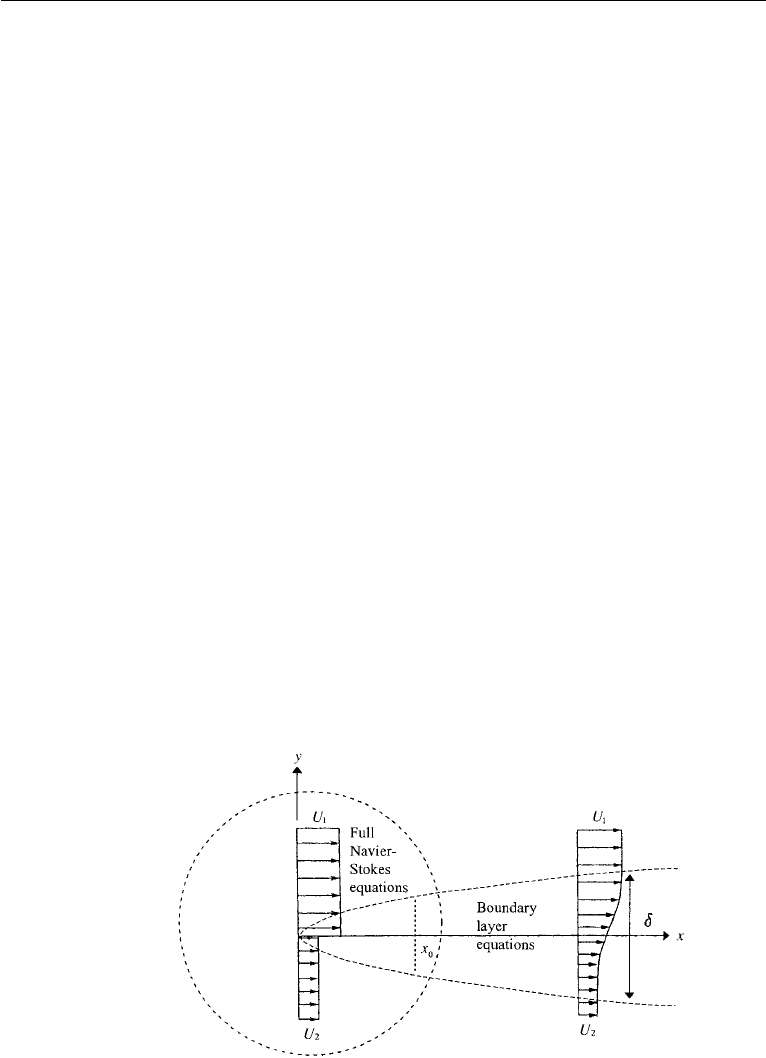
402 Boundary Layers and Related Topics
a detailed treatment of the decay of a laminar shear layer illustrates some interesting
points. The problem of the downstream smoothing of an initial velocity discontinuity
has not been completely solved even now, although considerable literature might
suggest otherwise. Thus it is appropriate to close this chapter with a problem that
remains to be put to rest. See Figure 10.35 for a general sketch of the problem. The
basic parameter is Re
x
= U
1
x/ν. In these terms the problem splits into distinct regions
as illustrated in Figure 10.11. This shown in the paper by Alston and Cohen (1992),
which also contains a brief historical summary. In the region for which Re
x
is finite,
the full Navier–Stokes equations are required for a solution. As Re
x
becomes large,
δ x,v u and the Navier–Stokes equations asymptotically decay to the boundary
layer equations. The boundary layer equations require an initial condition, which is
provided by the downstream limit of the solution in the finite Reynolds number region.
Here we see that, because they are of elliptic form, the full Navier–Stokes equations
require downstream boundary conditions on u and v (which would have to be provided
by an asymptotic matching). Paradoxically it seems, the downstream limit of the
Navier–Stokes equations, represented by the boundary layer equations, cannot accept
a downstream boundary condition because they are of parabolic form. The boundary
layer equations govern the downstream evolution from a specified initial station of
the streamwise velocity profile. In this problem there must be a matching between
the downstream limit of the initial finite Reynolds number region and the initial
condition for the boundary layer equations. Although the boundary layer equations
are a subset of the full Navier–Stokes equations and are generally appreciated to be the
resolution of d’Alembert’s paradox via a singular perturbation in the normal (say y)
direction, they are also a singular perturbation in the streamwise (say x) direction.
That is, the highest x derivative is dropped in the boundary layer approximation and
the boundary condition that must be dropped is the one downstream. This becomes an
issue in numerical solutions of the full Navier–Stokes equations. It arises downstream
in this problem as well.
Figure 10.35 Decay of a laminar shear layer.

17. Decay of a Laminar Shear Layer 403
If in Figure 10.35 the pressure in the top and bottom flow is the same, the boundary
layer formulation valid for x>x
0
, Re
x
0
1is
∂u
∂x
+
∂v
∂y
= 0,u
∂u
∂x
+ v
∂u
∂y
= ν
∂
2
u
∂y
2
,
y →+∞: u → U
1
,y→−∞: u → U
2
,
x = x
0
: U(x
0
,y) specified (initial condition). One boundary condition on v is
required.
We can look for a solution sufficiently far downstream that the initial condition
has been forgotten so that the similarity form has been achieved. Then,
η =
y
x
U
1
x
ν
and ψ(x, y) =
νU
1
xf (η).
In these terms u/U
1
= f
(η) and
f
+
1
2
ff
= 0,f
(∞) = 1,f
(−∞) = U
2
/U
1
.
Of course a third boundary condition is required for a unique solution. This represents
the need to specify one boundary condition on v. Let us see how far we can go towards
a solution and what the missing boundary condition actually pins down. Consider the
transformation f
(η) = F(f) = u/U
1
. Then
d
2
f
dη
2
= F
dF
df
and
d
3
f
dη
3
=
F
d
2
F
df
2
+
dF
df
2
F.
The Blasius equation transforms to
F
d
2
F
df
2
+
dF
df
2
+
1
2
f
dF
df
= 0, (10.99)
F(f =∞) = 1,F(f=−∞) = U
2
/U
1
. (10.100)
This has a unique solution for the streamwise velocity u/U
1
= F in terms of the
similarity streamfunction f(η) with the expected properties, which are shown in
Figure 10.36(a) and (b). The exact solution varies more steeply than the linearized
solution for small velocity difference, with the greatest difference between solutions
at the region of maximum curvature at the low velocity end. This difference is shown
more clearly in the magnified insets of each frame. The difference increases as the nor-
malized velocity difference, (U
1
−U
2
)/U
1
, increases. We can see from the (Blasius)
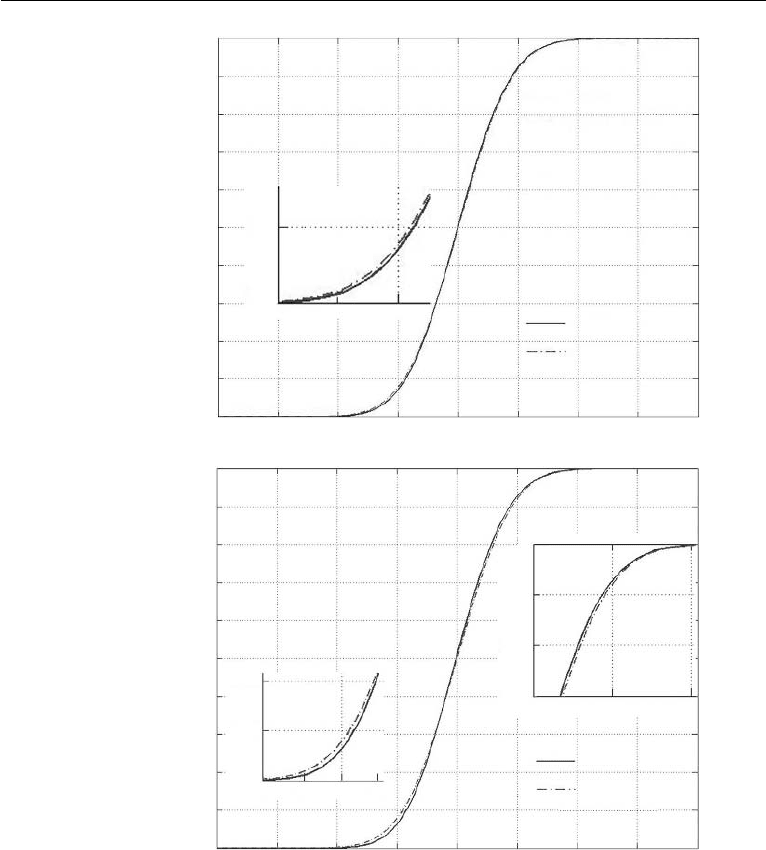
404 Boundary Layers and Related Topics
1
0.99
(a)
(b)
0.98
0.97
0.96
0.95
0.91
0.90
–3 –2
F
0.94
0.93
0.92
0.91
0.9
–8 –6 –4 –2 0
f
2468
numerical
analytical-linearized
1
0.98
0.96
0.92
F
0.88
0.86
0.84
0.82
0.8
–8 –6
–4
0.8
0.82
0.84
0.94
024
0.96
0.98
1
–3 –2 –1
–4 –2 0 2 4 6 8
0.9
0.94
f
numerical
analytical-linearized
Figure 10.36 Solution for F(f) from equation (10.99) subject to boundary conditions (10.100) when
(a) U
2
/U
1
= 0.9, and (b) U
2
/U
1
= 0.8. The “analytical—linearized” approximation is the asymptotic
solution for (U
1
− U
2
)/U
1
1 : F = 1 −[(U
1
− U
2
)/(2U
1
)]erfc(f/2). Magnified insets show the
difference between the two curves.
equation in η-space that the maximum of the shear stress occurs where f = 0. This
is the inflection point in the velocity profile in η or y. However, the inflection point
in the F(f) curve is located where f =−2 dF/df < 0. This is below the dividing
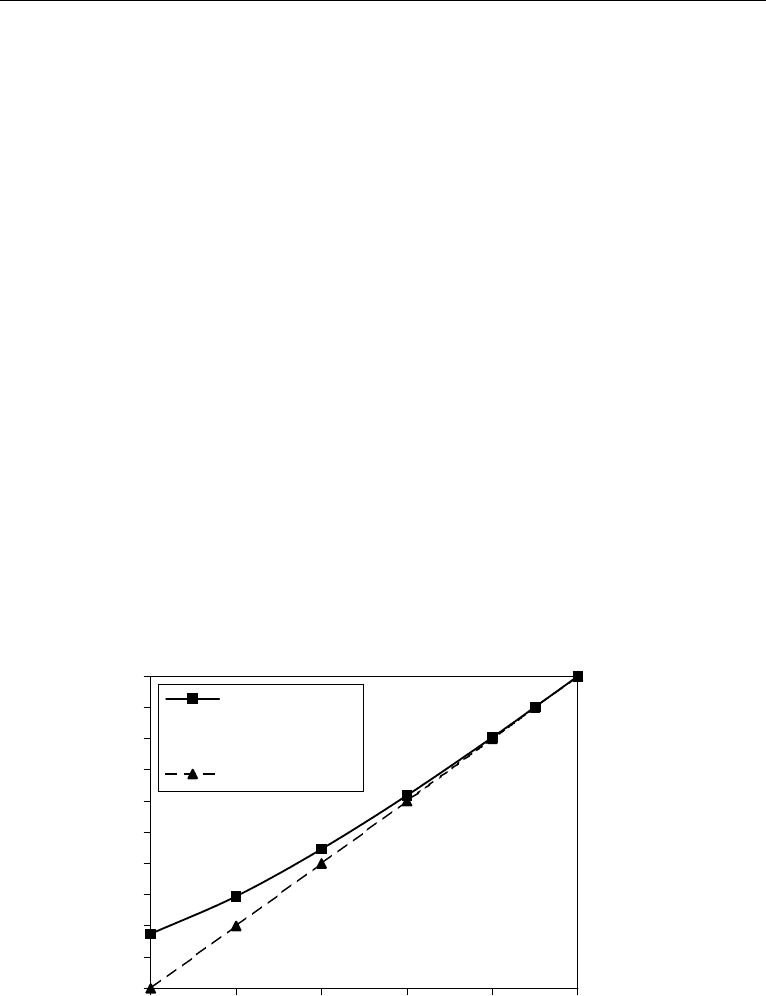
17. Decay of a Laminar Shear Layer 405
streamline f = 0. To put this back in physical space (x, y), the transformation must
be inverted,
dη =
df/F (f ).
The integral on the right-hand side can be calculated exactly but the correspon-
dence between any integration limit on the right-hand side and that on the left-hand
side is ambiguous. This solution admits a translation of η by any constant. The ambi-
guity in the location in y (or η) of the calculated profile was known to Prandtl. In the
literature, five different third boundary conditions have been used. They are as follows:
(a) f(η = 0) = 0 (v = 0ony or η = 0);
(b) f
(η = 0) = (1 +U
2
/U
1
)/2 (average velocity on the axis);
(c) ηf
− f → 0asη →∞(v → 0asη →∞);
(d) ηf
− f → 0asη →−∞(v → 0asη →−∞); and
(e) uv]
∞
+uv]
−∞
= 0orf
(ηf
−f)]
∞
+f
(ηf
−f)]
−∞
= 0 (von Karman;
zero net transverse force).
Alston and Cohen (1992) considered the limit of small velocity difference (U
2
−U
1
)/
U
1
1 and showed that none of these third boundary conditions are correct.
As the normalized velocity difference increases, we expect the error in using any of
the incorrect boundary conditions to increase. Of all of them, the last (e) is closest
to the correct result. D.-C. Hwang, in his doctoral dissertation (2005) has shown,
that as the normalized velocity difference (U
1
− U
2
)/U
1
increases, the trends seen
by Alston continue. Figure 10.37 shows that the streamwise velocity on the dividing
streamline (f = 0) is larger than the average velocity of the two streams, when the
upper stream is the faster one. What is not determined from the solution to (10.99)
0.5
0.55
0.6
0.65
0.7
0.75
0.8
0.85
0.9
0.95
1
0 0.2 0.4 0.6 0.8 1
U
2
/U
1
F (f 5 0)
From solution of
Eq. (10.99) with
(10.100)
(U
1
1U
2
)/(2U
1
)
Figure 10.37 Comparison of streamwise velocity at dividing streamline (f = 0) with average velocity
(dashed line).
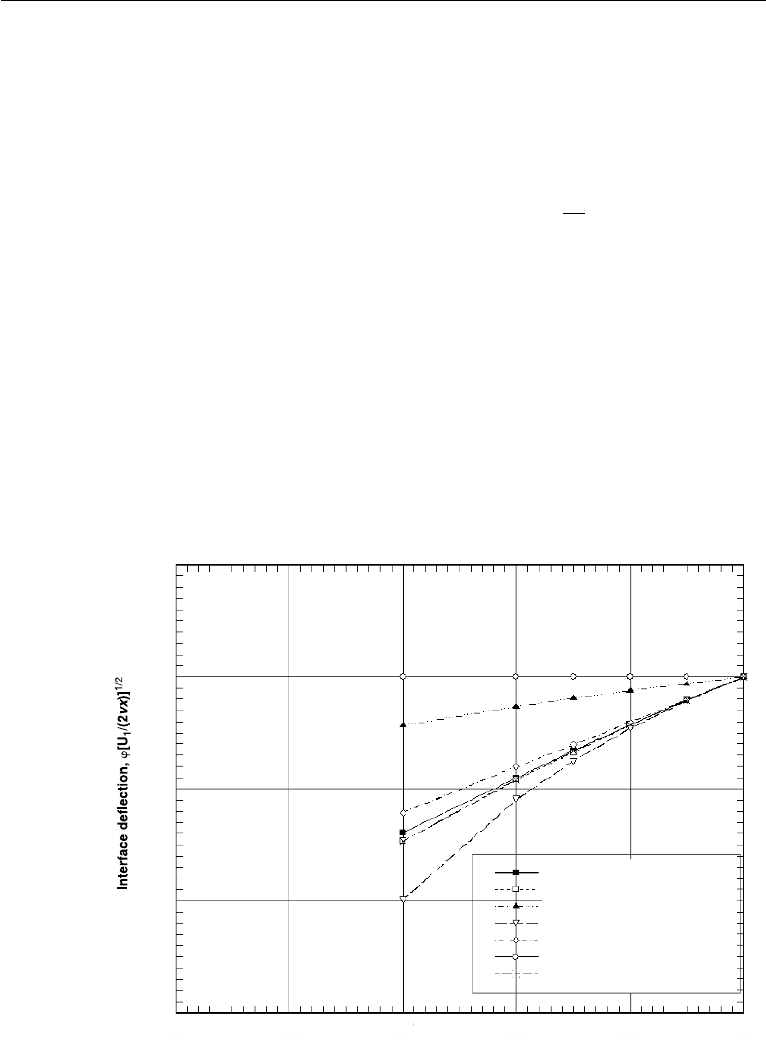
406 Boundary Layers and Related Topics
subject to (10.100) is the location of the dividing streamline, f = 0, because that
depends on the inverse transformation, which requires one more boundary condition
for a unique specification. When U
1
>U
2
, the dividing streamline ψ = 0, which
starts at the origin, bends slowly downwards and its path can be tracked only by start-
ing the solution at the origin and following the evolution of the equations downstream.
Thus, no simple statement of a third boundary condition is possible to complete the
similarity formulation. Following Klemp and Acrivos (1972), the deflection of the
dividing streamline from the x-axis was written by Hwang (2005) as ϕ(x). Then
a modified similarity variable η = (U
1
/ν)
1/2
(y − ϕ)/
√
2x was defined. In these
terms, the dividing streamline is η = 0 so that the boundary condition on the dividing
streamline is f(η = 0) = 0. However, the behavior of ϕ(x) had to be computed by
solving the Navier-Stokes equations from the origin. The downstream asymptote for
ϕ(x), which can be used as the third boundary condition for the similarity solution,
is shown in Figure 10.38 as a function of velocity ratio. The downstream distance to
achieve similarity is found to be given by Re = U
1
x/ν ≈ 10
4
. Although the results
of Alston and Cohen are difficult to distinguish on the graph from the von Karman
condition (e), the numerical calculation shows a clear distinction. Deviations become
larger as U
2
/U
1
diminishes. Beyond the point shown, computations became exces-
sively tedious.
Velocity ratio, U
2
/U
1
0.5
20.3
20.2
20.1
0.0
0.1
0.6 0.7 0.8 0.9 1.0
current solution (Hwang)
von Kármán condition
f(0) 5 Um 5 (U11U2)/2
f(0) 5 0, v(0) 5 0
Alston and Cohen
,
s result
v(h 5 2`) 5 0
v(h 5 `) 5 0
Figure 10.38 Asymptotic downstream dividing streamline deflection as a function of velocity ratio.

Exercises 407
Exercises
1. Solve the Blasius sets (10.34) and (10.35) with a computer, using the
Runge–Kutta scheme of numerical integration.
2. A flat plate 4 m wide and 1 m long (in the direction of flow) is immersed in
kerosene at 20
◦
C(ν = 2.29 ×10
−6
m
2
/s, ρ = 800 kg/m
3
) flowing with an undis-
turbed velocity of 0.5 m/s. Verify that the Reynolds number is less than critical every-
where, so that the flow is laminar. Show that the thickness of the boundary layer and
the shear stress at the center of the plate are δ = 0.74 cm and τ
0
= 0.2N/m
2
, and
those at the trailing edge are δ = 1.05 cm and τ
0
= 0.14 N/m
2
. Show also that the
total frictional drag on one side of the plate is 1.14 N. Assume that the similarity
solution holds for the entire plate.
3. Air at 20
◦
C and 100 kPa (ρ = 1.167 kg/m
3
, ν = 1.5 ×10
−5
m
2
/s) flows
over a thin plate with a free-stream velocity of 6 m/s. At a point 15 cm from the
leading edge, determine the value of y at which u/U = 0.456. Also calculate v and
∂u/∂y at this point. [Answer: y = 0.857 mm, v = 0.39 cm/s, ∂u/∂y = 3020 s
−1
.
You may not be able to get this much accuracy, because your answer will probably
use certain figures in the chapter.]
4. Assume that the velocity in the laminar boundary layer on a flat plate has the
profile
u
U
= sin
πy
2δ
.
Using the von Karman momentum integral equation, show that
δ
x
=
4.795
√
Re
x
,C
f
=
0.655
√
Re
x
.
Notice that these are very similar to the Blasius solution.
5. Water flows over a flat plate 30 m long and 17 m wide with a free-stream veloc-
ity of 1 m/s. Verify that the Reynolds number at the end of the plate is larger than the
critical value for transition to turbulence. Using the drag coefficient in Figure 10.12,
estimate the drag on the plate.
6. Find the diameter of a parachute required to provide a fall velocity no larger
than that caused by jumping from a 2.5 m height, if the total load is 80 kg. Assume
that the properties of air are ρ = 1.167 kg/m
3
, ν = 1.5 × 10
−5
m
2
/s, and treat the
parachute as a hemispherical shell with C
D
= 2.3. [Answer: 3.9 m]
7. Consider the roots of the algebraic equation
x
2
− (3 + 2ε)x + 2 +ε = 0,
for ε 1. By a perturbation expansion, show that the roots are
x =
1 − ε + 3ε
2
+···,
2 +3ε − 3ε
2
+···.
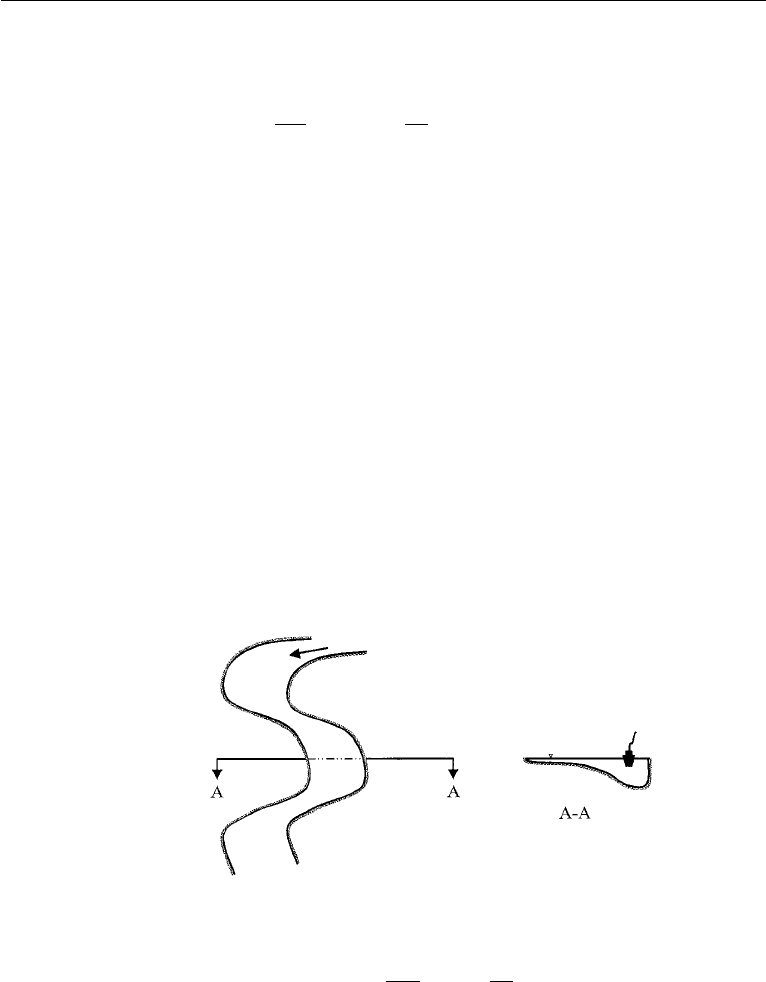
408 Boundary Layers and Related Topics
(From Nayfeh, 1981, p. 28 and reprinted by permission of John Wiley & Sons, Inc.)
8. Consider the solution of the equation
ε
d
2
y
dx
2
− (2x + 1)
dy
dx
+ 2y = 0,ε 1,
with the boundary conditions
y(0) = α, y(1) = β.
Convince yourself that a boundary layer at the left end does not generate “matchable”
expansions, and that a boundary layer at x = 1 is necessary. Show that the composite
expansion is
y = α(2x + 1) + (β − 3α)e
−3(1−x)/ε
+···.
For the two values ε = 0.1 and 0.01, sketch the solution if α = 1 and β = 0. (From
Nayfeh, 1981, p. 284 and reprinted by permission of John Wiley & Sons, Inc.)
9. Consider incompressible, slightly viscous flow over a semi-infinite flat plate
with constant suction. The suction velocity v(x, y = 0) = v
0
< 0 is ordered by
O(Re
−1/2
)<v
0
/U < O(1) where Re = Ux/ν →∞. The flow upstream is parallel
to the plate with speed U. Solve for u, v in the boundary layer.
10. Mississippi River boatmen know that when rounding a bend in the river,
they must stay close to the outer bank or else they will run aground. Explain in fluid
mechanical terms the reason for the cross-sectional shape of the river at the bend:
11. Solve to leading order in ε in the limit ε → 0
ε[x
−2
+ cos (ln x)]
d
2
f
dx
2
+ cos x
df
dx
+ sin xf = 0,
1 x 2,f(1) = 0,f(2) = cos 2.
12. A laminar shear layer develops immediately downstream of a velocity dis-
continuity. Imagine parallel flow upstream of the origin with a velocity discontinuity

Supplemental Reading 409
at x = 0 so that u = U
1
for y>0 and u = U
2
for y<0. The density may be
assumed constant and the appropriate Reynolds number is sufficiently large that the
shear layer is thin (in comparison to distance from the origin). Assume the static
pressures are the same in both halves of the flow at x = 0. Describe any ambiguities
or nonuniquenesses in a similarity formulation and how they may be resolved. In the
special case of small velocity difference, solve explicitly to first order in the smallness
parameter (velocity difference normalized by average velocity, say) and show where
the nonuniqueness enters.
13. Solve equation (10.99) subject to equation (10.100) asymptotically for small
velocity difference and obtain the result in the caption to Figure 10.36.
Literature Cited
Alston, T. M. and I. M. Cohen (1992). “Decay of a laminar shear layer.” Phys. Fluids A4: 2690–2699.
Bender, C. M. and S. A. Orszag (1978). Advanced Mathematical Methods for Scientists and Engineers.
New York: McGraw-Hill.
Falkner, V. W. and S. W. Skan (1931). “Solutions of the boundary layer equations.” Phil. Mag. (Ser. 7) 12:
865–896.
Gallo, W. F., J. G. Marvin, and A. V. Gnos (1970). “Nonsimilar nature of the laminar boundary layer.”
AIAA J. 8: 75–81.
Glauert, M. B. (1956). “The Wall Jet.” J. Fluid Mech. 1: 625–643.
Goldstein, S. (ed.). (1938). Modern Developments in Fluid Dynamics, London: Oxford University Press;
Reprinted by Dover, New York (1965).
Holstein, H. and T. Bohlen (1940). “Ein einfaches Verfahren zur Berechnung laminarer Reibungsschichten
die dem N
¨
aherungsverfahren von K. Pohlhausen gen¨ugen.” Lilienthal-Bericht. S. 10: 5–16.
Hwang, Din-Chih (2005). “Evolution of a laminar mixing layer.” Ph.D. dissertation, University of
Pennsylvania. Submitted for publication.
Klemp, J. B. and A. Acrivos (1972). “A note on the laminar mixing of two uniform parallel semi-infinite
streams.” Journal of Fluid Mechanics 55: 25–30.
Mehta, R. (1985). “Aerodynamics of sports balls.” Annual Review of Fluid Mechanics 17, 151–189.
Nayfeh, A. H. (1981). Introduction to Perturbation Techniques, New York: Wiley.
Peletier, L. A. (1972). “On the asymptotic behavior of velocity profiles in laminar boundary layers.” Arch.
for Rat. Mech. and Anal. 45: 110–119.
Pohlhausen, K. (1921). “Zur n
¨
aherungsweisen Integration der Differentialgleichung der laminaren
Grenzschicht.” Z. Angew. Math. Mech. 1: 252–268.
Rosenhead, L. (ed.). (1988). Laminar Boundary Layers, New York: Dover.
Schlichting, H. (1979). Boundary Layer Theory, 7th ed., New York: McGraw-Hill.
Serrin, J. (1967). “Asymptotic behaviour of velocity profiles in the Prandtl boundary layer theory.” Proc.
Roy. Soc. A299: 491–507.
Sherman, F. S. (1990). Viscous Flow, New York: McGraw-Hill.
Taneda, S. (1965). “Experimental investigation of vortex streets.” J. Phys. Soc. Japan 20: 1714–1721.
Thomson, R. E. and J. F. R. Gower (1977). “Vortex streets in the wake of the Aleutian Islands.” Monthly
Weather Review 105: 873–884.
Thwaites, B. (1949). “Approximate calculation of the laminar boundary layer.” Aero. Quart. 1: 245–280.
van Dyke, M. (1975). Perturbation Methods in Fluid Mechanics, Stanford, CA: The Parabolic Press.
von Karman, T. (1921). “
¨
Uber laminare und turbulente Reibung.” Z. Angew. Math. Mech. 1: 233–252.
Wen, C.-Y. and C.-Y. Lin (2001). “Two-dimensional vortex shedding of a circular cylinder.” Phys. Fluids
13: 557–560.
Yih, C. S. (1977). Fluid Mechanics: A Concise Introduction to the Theory, Ann Arbor, MI: West River
Press.

410 Boundary Layers and Related Topics
Supplemental Reading
Batchelor, G. K. (1967). An Introduction to Fluid Dynamics, London: Cambridge University Press.
Friedrichs, K. O. (1955). “Asymptotic phenomena in mathematical physics.” Bull. Am. Math. Soc. 61:
485–504.
Lagerstrom, P. A. and R. G. Casten (1972). “Basic concepts underlying singular perturbation techniques.”
SIAM Review 14: 63–120.
Meksyn, D. (1961). New Methods in Laminar Boundary Layer Theory, New York: Pergamon Press.
Panton, R. L. (1984). Incompressible Flow, New York: Wiley.

Chapter 11
Computational Fluid Dynamics
by Howard H. Hu
University of Pennsylvania
Philadelphia, PA, USA
1. Introduction ..................... 411
2. Finite Difference Method ......... 413
Approximation to Derivatives .... 413
Discretization and Its Accuracy. . . 414
Convergence, Consistency, and
Stability ...................... 415
3. Finite Element Method ........... 418
Weak or Variational Form of Partial
Differential Equations ......... 418
Galerkin’s Approximation and
Finite Element Interpolations . . 420
Matrix Equations, Comparison
with Finite Difference Method. . 421
Element Point of View of the
Finite Element Method ........ 424
4. Incompressible Viscous Fluid Flow 426
Convection-Dominated
Problems...................... 427
Incompressibility Condition ...... 429
Explicit MacCormack Scheme.... 430
MAC Scheme .................... 433
-Scheme....................... 437
Mixed Finite Element
Formulation................... 438
5. Three Examples ................. 440
Explicit MacCormack Scheme for
Driven Cavity Flow Problem . . . 440
Explicit MacCormack Scheme for
Flow Over a Square Block ..... 444
Finite Element Formulation for
Flow Over a Cylinder Confined
in a Channel .................. 450
6. Concluding Remarks ............. 461
Exercises ........................ 463
Literature Cited .................. 464
1. Introduction
Computational Fluid Dynamics (CFD) is a science that, with the help of digital com-
puters, produces quantitative predictions of fluid-flow phenomena based on those
conservation laws (conservation of mass, momentum, and energy) governing fluid
motion. These predictions normally occur under those conditions defined in terms of
flow geometry, the physical properties of a fluid, and the boundary and initial con-
ditions of a flow field. The prediction generally concerns sets of values of the flow
variables, for example, velocity, pressure, or temperature at selected locations in the
domain and for selected times. It may also evaluate the overall behavior of the flow,
such as the flow rate or the hydrodynamic force acting on an object in the flow.
411
©2010 Elsevier Inc. All rights reserved.
DOI: 10.1016/B978-0-12-381399-2.50011-3
